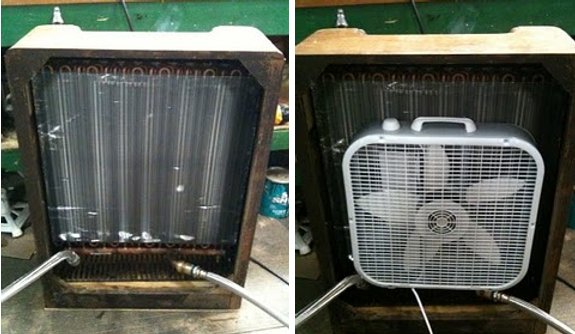
More DIY low budget geothermal cooling

If you live near a lake or
some other source of cold water you could pump that water through an
old radiator and then blow the coldness out with a simple fan.
I found this clever solution
at the Straw
Bale Retreat blog.
Now I'm wondering how much
cold air I could harvest from our nearby creek using this method?
Want more in-depth information? Browse through our books.
Or explore more posts by date or by subject.
About us: Anna Hess and Mark Hamilton spent over a decade living self-sufficiently in the mountains of Virginia before moving north to start over from scratch in the foothills of Ohio. They've experimented with permaculture, no-till gardening, trailersteading, home-based microbusinesses and much more, writing about their adventures in both blogs and books.
Want to be notified when new comments are posted on this page? Click on the RSS button after you add a comment to subscribe to the comment feed, or simply check the box beside "email replies to me" while writing your comment.

That might work quite well. Do put a decent filter before the radiator. Those narrow tubes can clog quite easily.
It could be even nicer to turn it around; build a funnel outside where you spray (atomize) the river water over ducts circulating the house's air; vaporizing water takes much more energy (2257 kJ/kg) than just heating it up (4.2 J/(kg K)). (That's why you see these big cooling towers next to powerplants)
There are basically two things that determine the capacity of a heat exchanger (which these are);
An even cooler idea (pun intended ) would be to use heat from the sun to drive an Einstein-Szilard heat pump and use that as an air conditioner. The heat of the sun would then provide you with cooling.
) would be to use heat from the sun to drive an Einstein-Szilard heat pump and use that as an air conditioner. The heat of the sun would then provide you with cooling.
This would work well at night. I think the larger benefit for you would be the humidity removal from your inside air. The cool creek water running through the radiator will condensate the humidity. Maybe use collection for drinking water? It should be cool. You could just divert one line of your sprinkler system. Then cool as you water?
Fun idea.
What I had in mind is more like a cooling tower. Unless you're in an arid climate, a swamp cooler would probably bring too much moisture directly in the house.
BTW, if your house is on higher ground than the creek, make sure to run a return hose back to the creek, to make life easier on the pump...
The water going down will balance out the water going up, so your pump only has to cope with the resistance in the hoses, not gravity. This is basically the same trick as using balance weights on an elevator.
Roland and Erich --- you two sure have set the wheels in our heads turning. I'll bet if we hooked something up from our well rather than from our creek, the extra coolness (and closeness) might make it more efficient than Mark's air conditioner. On the other hand, we'd have to pump the excess water uphill to return it to the well, so it might not work as well. (Or we could send the water into an irrigation setup, but our well doesn't have enough water for real irrigation, so not sure about that...)
I suspect you'll see Mark starting to experiment with this soon!
If the well is higher than the house, and you don't make a return line, you might not even need a pump at all, or a very small one. Depending on the "head" and the resistance in the pipe and the radiator, you can let gravity do the pumping.
The rule of thumb is;
You have to think in terms of gravity and potential energy.
Of course there are other considerations. E.g. is the well water potable and worth saving? In that case consider guiding it to your fresh water tank. &c.
This might interest you as well: efficient air conditioning by evaporation and drying.
Might be a while before it is comercially available, though.